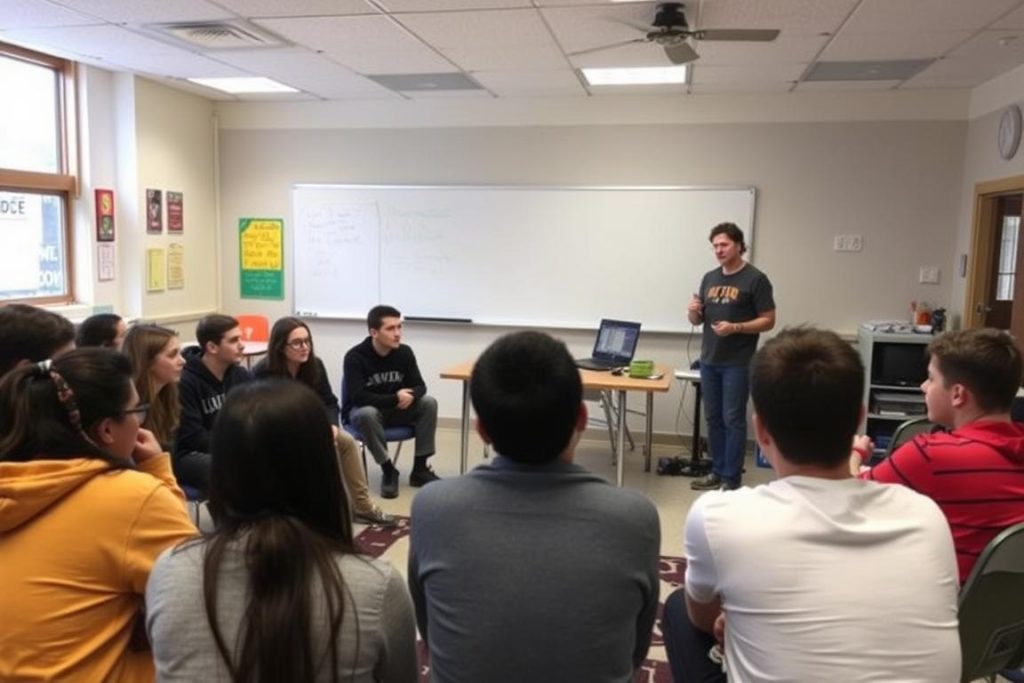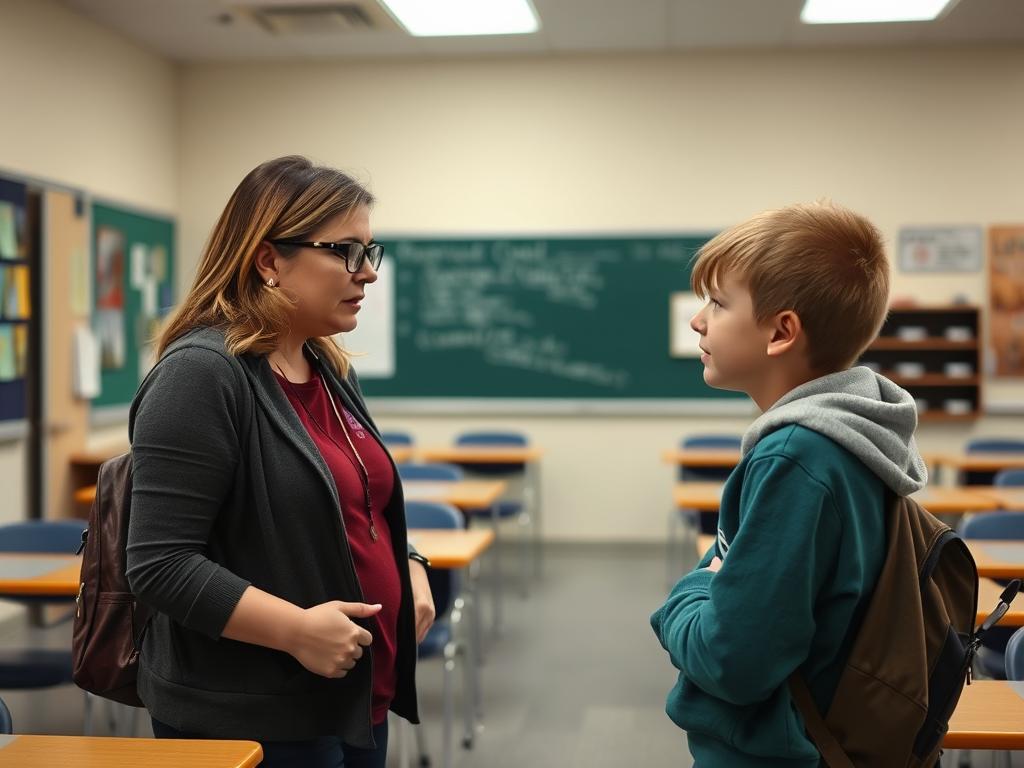Understanding Love and Logic Examples Through Its Foundation
The Love and Logic approach combines empathy with logical consequences to help students develop responsibility for their actions. Rather than relying on punitive measures, this methodology empowers students to make choices and learn from natural outcomes. Developing these teacher skills requires practice but yields significant improvements in classroom culture.
Love and Logic creates a classroom environment where students learn responsibility through empathy and natural consequences
Jim Fay, one of the founders of Love and Logic, emphasizes that this approach isn’t about controlling students but rather teaching them to control themselves. By implementing these teacher skills consistently, educators create classrooms where students feel valued and develop intrinsic motivation.
Ready to transform your classroom management?
Discover how Love and Logic principles can earn you professional development credits while enhancing your teacher skills.
Love and Logic Examples for Principle #1: Shared Control
The first core principle of Love and Logic focuses on sharing control with students through meaningful choices. This builds ownership and reduces power struggles—essential teacher skills for maintaining classroom harmony.
Practical Examples of Shared Control
“Would you like to complete your math problems at your desk or at the reading table?” instead of “Complete your math problems now.”
This Love and Logic example demonstrates how offering small, controlled choices helps students feel empowered while still accomplishing necessary tasks. These teacher skills create win-win situations where students practice decision-making within appropriate boundaries.
More Shared Control Examples:
- “You can turn in your project on Tuesday or Wednesday. You decide which works better for your schedule.”
- “Would you prefer to work with a partner or individually on this assignment?”
- “You can use colored pencils or markers for this activity. Which would you like?”
Research shows that when students are given appropriate choices, they develop greater ownership of their learning and exhibit fewer behavioral issues. These Love and Logic examples help teachers build student autonomy while maintaining necessary structure.
Learn how these shared control techniques can enhance your teacher skills →
Love and Logic Examples for Principle #2: Empathy Before Consequences
The second core principle emphasizes responding to misbehavior with genuine empathy before delivering consequences. This powerful combination of teacher skills helps students connect their choices with outcomes without damaging relationships.

How Empathy Changes Student Response
“Oh, that’s so sad you chose not to complete your assignment. I was really looking forward to seeing your work. What do you think you should do now?”
This Love and Logic example demonstrates how expressing genuine empathy before addressing consequences helps students focus on problem-solving rather than defensiveness. These teacher skills create an emotional environment where students can learn from mistakes.
Traditional Approach:
“You didn’t do your homework again? That’s detention!”
Result: Student feels attacked and focuses on the teacher rather than their own choices.
Love and Logic Approach:
“Oh, how sad about the homework. I know that affects your grade. What’s your plan for handling this?”
Result: Student must think about their choices and develop a solution.
Developing these teacher skills requires practice but creates a classroom where students learn to connect their actions with outcomes. The empathy component is crucial—it must be genuine rather than sarcastic to be effective.
Master the empathy-with-consequences approach
Earn professional development credits while learning to implement these powerful Love and Logic examples in your classroom.
Love and Logic Examples for Principle #3: Equal Shares of Control
The third principle focuses on maintaining an equal balance of control between teachers and students. This requires specific teacher skills to create boundaries while still offering appropriate freedom.

Setting Boundaries with Enforceable Statements
Enforceable statements are among the most powerful Love and Logic examples because they focus only on what you can control. These teacher skills help avoid power struggles while maintaining necessary boundaries.
“I’ll be happy to start the lesson when everyone is seated” instead of “Sit down right now!”
More Enforceable Statement Examples:
- “I listen to students who raise their hands.”
- “I’ll be glad to check homework that’s turned in before class starts.”
- “Feel free to join us when you’re ready to participate appropriately.”
These Love and Logic examples demonstrate how teachers can maintain authority without creating unnecessary conflict. By focusing on what you will do rather than trying to control student behavior directly, these teacher skills create a more respectful classroom dynamic.
According to a 2013 study published in the Journal of Research in Childhood Education, classrooms that implement this balanced approach to control show significant improvements in student self-regulation and decreased behavioral issues.
Love and Logic Examples for Principle #4: Delayed Consequences
The fourth principle involves delaying consequences when emotions are high. This powerful set of teacher skills allows both educators and students to make better decisions when calm.

The Power of “I’ll Have to Think About This”
“I need some time to think about what happened and decide what to do. Let’s talk about this after class.”
This Love and Logic example demonstrates how delaying consequences allows everyone to calm down and make better decisions. These teacher skills prevent reactive responses that often escalate situations.
Why Delayed Consequences Work:
- Gives teachers time to consider appropriate responses
- Allows students to reflect on their choices
- Prevents emotional reactions from either party
- Creates anticipatory consequences (students often imagine worse than reality)
Implementing these teacher skills requires patience but yields significant improvements in classroom management. Love and Logic examples like these help create thoughtful responses rather than reactive punishments.
Discover more strategies for implementing delayed consequences →
Love and Logic Examples for Principle #5: Shared Thinking
The fifth principle focuses on encouraging students to think for themselves rather than relying on teacher directives. These teacher skills help develop student problem-solving abilities and independence.

Guiding Questions Instead of Solutions
“What do you think might happen if you choose that option?” instead of “Don’t do that, it’s a bad idea.”
This Love and Logic example demonstrates how asking questions rather than providing answers helps students develop critical thinking skills. These teacher skills create independent problem-solvers rather than direction-followers.
More Shared Thinking Questions:
- “How might you solve this problem?”
- “What do you think would be a fair solution?”
- “What might be another way to approach this?”
- “How has that strategy worked for you in the past?”
These Love and Logic examples help teachers guide students toward developing their own solutions. By implementing these teacher skills consistently, educators create classrooms where students learn to think critically about their choices.
Ready to implement these Love and Logic examples?
Earn professional development credits while mastering these essential teacher skills.
Implementing Love and Logic Examples in Your Classroom
Starting with Love and Logic doesn’t mean overhauling your entire classroom management approach overnight. Begin by selecting one principle and practicing the associated teacher skills until they become natural.
Step-by-Step Implementation Plan
- Choose one principle to start with – Many teachers find the “Empathy Before Consequences” principle provides quick results.
- Practice specific phrases – Rehearse Love and Logic examples until they feel natural.
- Start small – Apply your chosen principle in one class period or with one challenging student.
- Reflect and adjust – Keep track of what works and modify your approach as needed.
- Add additional principles – Once comfortable, incorporate additional Love and Logic examples into your teacher skills.
Remember that developing these teacher skills takes time and practice. The Love and Logic examples provided here serve as starting points that you can adapt to your specific classroom needs.
Learn how to earn credits while implementing these strategies →
Conclusion: The Impact of Love and Logic Examples
Implementing Love and Logic examples in your classroom creates an environment where students learn responsibility through natural consequences while maintaining positive relationships. These teacher skills help transform challenging situations into opportunities for growth and learning.
By focusing on shared control, empathy before consequences, enforceable statements, delayed consequences, and shared thinking, educators develop a comprehensive set of teacher skills that promote student independence and responsibility.
The journey to mastering these Love and Logic examples takes time, but the results—improved classroom culture, reduced power struggles, and increased student ownership—make the effort worthwhile. Start with one principle, practice consistently, and watch as your classroom transforms.
Ready to transform your classroom with Love and Logic?
Earn professional development credits while mastering these essential teacher skills that will revolutionize your classroom management approach.




